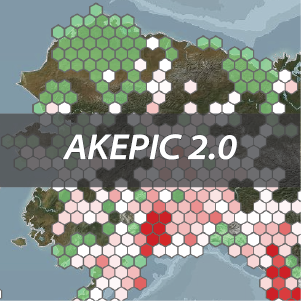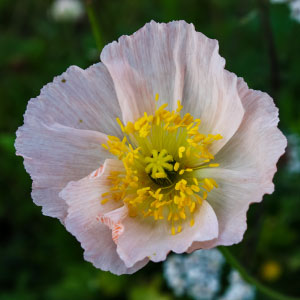The Alaska Exotic Plants Information Clearinghouse (AKEPIC) is a database and mapping application that provide geospatial information for non-native plant species in Alaska and neighboring Canadian Territories. These products are the result of an ongoing cooperation among the U.S. Forest Service, National Park Service, Bureau of Land Management, U.S. Fish and Wildlife Service, Department of Natural Resources Plant Material Center, and Alaska Center for Conservation Science (ACCS) in support of the Alaska Invasive Species Partnership (AKISP) and the Strategic Plan for Noxious and Invasive Plants Management in Alaska. ACCS administers the mapping application, database, and website associated with the project; project funding is granted by collaborators and contributed by users. These data are primarily intended to support the identification of problem species and infestations, thus promoting early detection and rapid response across Alaska. Additionally, the data are used in a variety of research and modeling activities.
ACCS tracks all non-native plants known to occur in Alaska. In addition, ACCS has compiled biographies for over half of the 400 non-native plant species that are known or likely to occur in Alaska. In collaboration with biologists, land managers, and weed scientists across the state, ACCS has developed an invasive plant ranking system that helps evaluate the potential invasiveness and impacts of non-native plants to natural areas in Alaska (Carlson et al. 2008). With funding support from the U.S. Forest Service, the Alaska Association of Conservation Districts, and the University of Alaska, we have ranked approximately 170 non-native plant species to date.
Most Recent AKEPIC Data Upload: 18 November 2025 with 172 records
ArcGIS Web Service for AKEPIC
An ArcGIS REST API feature to access AKEPIC is available. Using the REST service allows users to pull data from the AKEPIC dataportal directly into their ArcGIS Pro application using a secure http service. This eliminates the need for data managers to download and refresh AKEPIC data for every use. Click the button below:
Contact for AKEPIC
For questions or comments related to the AKEPIC project, procedures for collecting or submitting presence/absence data, or non-native plant identification or systematics, please contact Justin Fulkerson (primary contact). For more information on submitting data to AKEPIC, conducting non-native plant surveys, and identification of non-native plants, click the button below:
Citation for AKEPIC Data
AKEPIC (Year). Alaska Exotic Plant Information Clearinghouse database ( https://akepic.portal.axds.co). Alaska Center for Conservation Science, University of Alaska, Anchorage. Accessed (Month, Date, Year).
Other Resources
Non-Native Plants
AKEPIC Identification Book
This field guide provides a resource for non-native plant identifications of most common non-native plant species currently known to occur in Alaska.
Invasive.org Information and images of invasive and exotic species of North America; based at The University of Georgia’s Center for Invasive Species and Ecosystem Health.
Center for Invasive Plant Management
Promotes ecologically sound management of invasive plants by facilitating collaboration and partnerships among scientists, educators, and land managers; based at Montana State University.
Alaska Invasive Species Partnership (AKISP)
Aims to heighten the awareness of the problems associated with non-native invasive plants and to bring about greater statewide coordination, cooperation and action to halt the introduction and spread of undesirable plants.
Cooperative Extension Service The Alaska Integrated Pest Management Program addresses the public need for pest management education within the state. General educational outreach services provided include evaluation and identification of insect, plant and disease specimens, recommendation of control options to reduce pest problems and site visits to examine tree disorders and invasive plants in the field.
AACD (Alaska Association of Conservation Districts)
Actively supports 12 statewide Soil and Water Conservation Districts. The Invasive Plant program coordinates the districts efforts to combat invasive weeds.
Alaska Department of Fish and Game
Information on invasive plant species considered ‘high priority threats’.
US Forest Service – Forest Health Protection Invasive Plants program works to protect Alaska’s forest and tree resources from damaging outbreaks of insects, diseases, and invasive plants.
General Botany
eFloras
A compilation of floras including, in part, the Flora North America.
ITIS (Integrated Taxonomic Information System)
Taxonomic information on plants, animals, fungi, and microbes of North America and the world.
USDA PLANTS Database
Standardized information about the vascular plants, mosses, liverworts, hornworts, and lichens of the U.S. and its territories.
CPNWH (Consortium of Pacific Northwest Herbaria)
An online database of ~3.6 million specimen records from over 40 herbaria in the Pacific Northwest, Canada, and Alaska. A single online access point to the wealth of existing and emerging information about the Pacific Northwest flora (includes native and non-native species).
Alaska Plant Materials Center
Provides testing, production, development, and distribution of materials to resource industries to meet environmental requirements and includes development of a native seed industry.
Cooperative Weed Management Areas
Groups of federal, state, and local land managers together with private citizens who have agreed to work together to protect Alaska from the threat of noxious, invasive weeds.
- Anchorage
- Copper Basin & Cordova
- Fairbanks
- Kenai Peninsula
- Kodiak
- Juneau (site under development)
- Mat-Su
- Salcha/Delta



